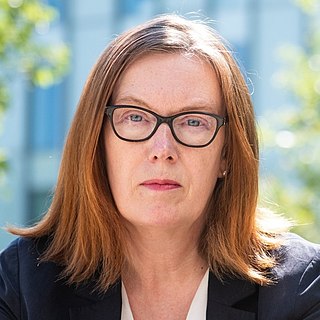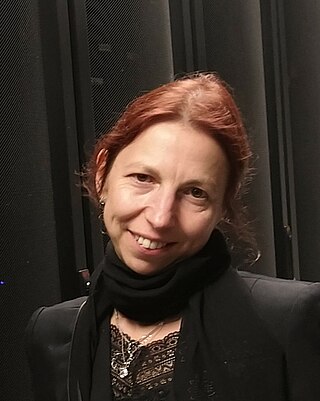Related Research Articles

Francis Harry Compton Crick was an English molecular biologist, biophysicist, and neuroscientist. He, James Watson, Rosalind Franklin, and Maurice Wilkins played crucial roles in deciphering the helical structure of the DNA molecule.

Biophysics is an interdisciplinary science that applies approaches and methods traditionally used in physics to study biological phenomena. Biophysics covers all scales of biological organization, from molecular to organismic and populations. Biophysical research shares significant overlap with biochemistry, molecular biology, physical chemistry, physiology, nanotechnology, bioengineering, computational biology, biomechanics, developmental biology and systems biology.

Rosalind Elsie Franklin was a British chemist and X-ray crystallographer whose work was central to the understanding of the molecular structures of DNA, RNA, viruses, coal, and graphite. Although her works on coal and viruses were appreciated in her lifetime, Franklin's contributions to the discovery of the structure of DNA were largely unrecognized during her life, for which Franklin has been variously referred to as the "wronged heroine", the "dark lady of DNA", the "forgotten heroine", a "feminist icon", and the "Sylvia Plath of molecular biology".

Maurice Hugh Frederick Wilkins was a New Zealand-born British biophysicist and Nobel laureate whose research spanned multiple areas of physics and biophysics, contributing to the scientific understanding of phosphorescence, isotope separation, optical microscopy and X-ray diffraction. He is known for his work at King's College London on the structure of DNA.
The year 1953 involved numerous significant events in science and technology, including the first description of the DNA double helix, the discovery of neutrinos, and the release of the first polio vaccine.

"Molecular Structure of Nucleic Acids: A Structure for Deoxyribose Nucleic Acid" was the first article published to describe the discovery of the double helix structure of DNA, using X-ray diffraction and the mathematics of a helix transform. It was published by Francis Crick and James D. Watson in the scientific journal Nature on pages 737–738 of its 171st volume.
Alexander Rawson Stokes was a British physicist at Royal Holloway College, London and later at King's College London. He was most recognised as a co-author of the second of the three papers published sequentially in Nature on 25 April 1953 describing the correct molecular structure of DNA. The first was authored by Francis Crick and James Watson, and the third by Rosalind Franklin and Raymond Gosling.

Steven M. Block is an American biophysicist and Professor at Stanford University with a joint appointment in the departments of Biology and Applied Physics. In addition, he is a member of the scientific advisory group JASON, a senior fellow of Stanford's Freeman Spogli Institute for International Studies, and an amateur bluegrass musician. Block received his B.A. and M.A. from Oxford University. He has been elected to the U.S. National Academy of Sciences (2007) and the American Academy of Arts and Sciences (2000) and is a winner of the Max Delbruck Prize of the American Physical Society (2008), as well as the Single Molecule Biophysics Prize of the Biophysical Society (2007). He served as President of the Biophysical Society during 2005-6. His graduate work was completed in the laboratory of Howard Berg at the University of Colorado and Caltech. He received his Ph.D. in 1983 and went on to do postdoctoral research at Stanford. Since that time, Block has held positions at the Rowland Institute for Science, Harvard University, and Princeton University before returning to Stanford in 1999.
The history of molecular biology begins in the 1930s with the convergence of various, previously distinct biological and physical disciplines: biochemistry, genetics, microbiology, virology and physics. With the hope of understanding life at its most fundamental level, numerous physicists and chemists also took an interest in what would become molecular biology.

Martin Karplus is an Austrian and American theoretical chemist. He is the Director of the Biophysical Chemistry Laboratory, a joint laboratory between the French National Center for Scientific Research and the University of Strasbourg, France. He is also the Theodore William Richards Professor of Chemistry, emeritus at Harvard University. Karplus received the 2013 Nobel Prize in Chemistry, together with Michael Levitt and Arieh Warshel, for "the development of multiscale models for complex chemical systems".

Eva Nogales is a Spanish-American biophysicist at the Lawrence Berkeley National Laboratory and a professor at the University of California, Berkeley, where she served as head of the Division of Biochemistry, Biophysics and Structural Biology of the Department of Molecular and Cell Biology (2015–2020). She is a Howard Hughes Medical Institute investigator.

Arieh Warshel is an Israeli-American biochemist and biophysicist. He is a pioneer in computational studies on functional properties of biological molecules, Distinguished Professor of Chemistry and Biochemistry, and holds the Dana and David Dornsife Chair in Chemistry at the University of Southern California. He received the 2013 Nobel Prize in Chemistry, together with Michael Levitt and Martin Karplus for "the development of multiscale models for complex chemical systems".
Sir John Turton Randall, was an English physicist and biophysicist, credited with radical improvement of the cavity magnetron, an essential component of centimetric wavelength radar, which was one of the keys to the Allied victory in the Second World War. It is also the key component of microwave ovens.

Elspeth Frances Garman is a retired professor of molecular biophysics at the University of Oxford and a former President of the British Crystallographic Association. Until 2021 she was also Senior Kurti Research Fellow at Brasenose College, Oxford, where she is now an emeritus fellow. The "Garman limit", which is the radiation dose limit of a cryocooled protein crystal, is named after her.
Rosalind Jane Allen is a soft matter physicist and Professor of Theoretical Microbial Ecology at the Biological Physics at the Friedrich-Schiller University of Jena, Germany, and (part-time) Professor of Biological Physics at the University of Edinburgh, Scotland She is a member of the centre for synthetic biology and systems biology where her research investigates the organisation of microbe populations.

Dame Sarah Catherine Gilbert FRS is an English vaccinologist who is a Professor of Vaccinology at the University of Oxford and co-founder of Vaccitech. She specialises in the development of vaccines against influenza and emerging viral pathogens. She led the development and testing of the universal flu vaccine, which underwent clinical trials in 2011.

Sarah Anne Harris is a British physicist who is an Associate Professor of Biological Physics at the University of Leeds. Her research investigates biomolecular simulations and the topology of DNA. In particular, she makes use of molecular dynamics to explore how DNA responds to stress. She serves as chair of the Engineering and Physical Sciences Research Council (EPSRC) computational collaborative project in Biomolecular simulation.
Melissa Louise Mather is an Australian physicist who is Professor in Biological Sensing and Imaging at the University of Nottingham. Her research considers the development of novel sensing techniques, including ultrasound, single molecule imaging and nitrogen-vacancy centers in diamond.
Olga Dudko is a Ukrainian physicist who is a professor at the University of California, San Diego. Her research makes use of theoretical physics to understand complex biological problems. She was elected Fellow of the American Physical Society in 2022.
References
- ↑ Byron, Olwyn (1992). Solution studies on the conformation and assembly of the monoclonal antibody B72.3. University of Nottingham. OCLC 557345582.
- ↑ "About". Physics of Life. Retrieved 16 March 2022.
- ↑ "About the BBS · British Biophysical Society". britishbiophysics.org. Retrieved 16 March 2022.
- ↑ "Rosalind Franklin Medal and Prize recipients". Rosalind Franklin Medal and Prize recipients | Institute of Physics. Retrieved 16 March 2022.
- ↑ "Stories - Department of Physics - University of Liverpool". www.liverpool.ac.uk. Retrieved 16 March 2022.